
110 Lydia is a large belt asteroid with an M-type spectrum, and thus may be metallic in composition, consisting primarily of nickel-iron. It was discovered by French astronomer Alphonse Borrelly on 19 April 1870 and was named for Lydia, the Asia Minor country populated by Phrygians. The Lydia family of asteroids is named after it.
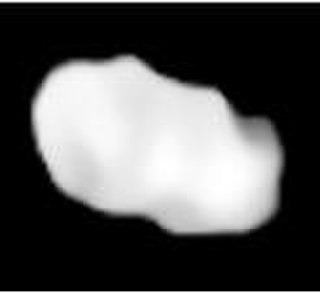
130 Elektra is a large outer main-belt asteroid and quadruple system with three minor-planet moons. It was discovered on 17 February 1873, by astronomer Christian Peters at Litchfield Observatory, New York, and named after Electra, an avenger in Greek mythology.
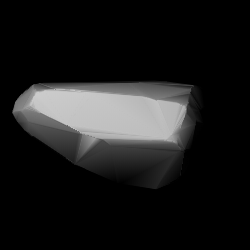
136 Austria is a main-belt asteroid that was found by the prolific asteroid discoverer Johann Palisa on 18 March 1874, from the Austrian Naval Observatory in Pola, Istria. It was his first asteroid discovery and was given the Latin name of his homeland.

165 Loreley is a main-belt asteroid that was discovered by C. H. F. Peters on August 9, 1876, in Clinton, New York and named after the Lorelei, a figure in German folklore.

166 Rhodope is a dark background asteroid from the central region of the asteroid belt, approximately 55 kilometers in diameter. It was discovered on 15 August 1876, by German–American astronomer Christian Peters at the Litchfield Observatory in Clinton, New York, United States. The asteroid was named after Queen Rhodope from Greek mythology.

196 Philomela is a large and bright main-belt asteroid. It is an S-type asteroid.

218 Bianca is a sizeable Main belt asteroid. It is an S-type asteroid. It was discovered by Johann Palisa on 4 September 1880, in Pola and was named after the Austro-Hungarian opera singer Bianca Bianchi. The Vienna newspapers contained several published accounts of the circumstances surrounding the honor extended to the diva in Spring 1882. In the late 1990s, a network of astronomers worldwide gathered lightcurve data that was ultimately used to derive the spin states and shape models of ten new asteroids, including (218) Bianca. The shape model for this asteroid is asymmetrical.
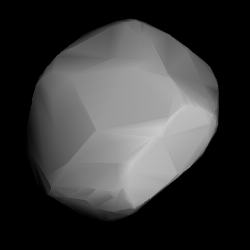
238 Hypatia is a large main-belt asteroid that was discovered by Russian astronomer Viktor Knorre on July 1, 1884, in Berlin. It was the third of his four asteroid discoveries. The name was given in honour of philosopher Hypatia of Alexandria. Based upon the spectrum, it is classified as a C-type asteroid and is probably composed of primitive carbonaceous material. Like many asteroids of this type, its surface is very dark in colour.
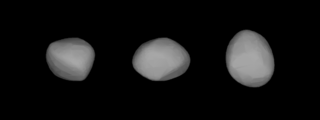
306 Unitas is a typical main belt asteroid that was discovered by Elia Millosevich on 1 March 1891 in Rome. The asteroid was named by the director of the Modena Observatory in honor of the Italian astronomer Angelo Secchi and the unification of Italy. It is classified as an S-type asteroid.

308 Polyxo is a main-belt asteroid that was discovered by A. Borrelly on March 31, 1891, in Marseilles. It is orbiting the Sun at a distance of 2.75 AU with a low orbital eccentricity (ovalness) of 0.04 and a period of 4.56 yr. The orbital plane is tilted at an angle of 4.36° to the plane of the ecliptic.
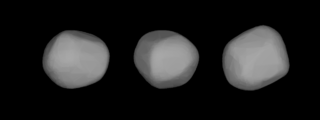
423 Diotima is one of the larger main-belt asteroids. It is classified as a C-type asteroid and is probably composed of primitive carbonaceous material.

776 Berbericia is a minor planet orbiting the Sun. A main-belt C-type asteroid, it was discovered on 24 January 1914 by astronomer Adam Massinger at Heidelberg Observatory in southwest Germany. It was named by Max Wolf in honor of Adolf Berberich (1861–1920), a German astronomer. The spectra of the asteroid displays evidence of aqueous alteration.
925 Alphonsina, provisional designation 1920 GM, is a stony Hansian asteroid from the central region of the asteroid belt, approximately 58 kilometers in diameter. It was discovered on 13 January 1920, by Catalan astronomer Josep Comas i Solà at the Fabra Observatory in Barcelona, Spain. The S-type asteroid has a rotation period of 7.88 hours. It was named for the Spanish Kings Alfonso X and Alfonso XIII.
1143 Odysseus, provisional designation 1930 BH, is a large Jupiter trojan located in the Greek camp of Jupiter's orbit. It was discovered on 28 January 1930, by German astronomer Karl Reinmuth at the Heidelberg Observatory in southwest Germany, and later named after Odysseus, the legendary hero from Greek mythology. The dark D-type asteroid has a rotation period of 10.1 hours. With a diameter of approximately 125 kilometers, it is among the 10 largest Jovian trojans.

1665 Gaby, provisional designation 1930 DQ, is a stony asteroid and a relatively slow rotator from the inner regions of the asteroid belt, approximately 11 kilometers in diameter. It was discovered on 27 February 1930, by German astronomer Karl Reinmuth at Heidelberg Observatory in southern Germany. It was later named after Gaby Reinmuth, the discoverer's daughter-in-law.

1188 Gothlandia, provisional designation 1930 SB, is a stony Florian asteroid from the inner regions of the asteroid belt, approximately 12 kilometers in diameter. Discovered by astronomer Josep Comas i Solà at the Fabra Observatory in 1930, the asteroid was later named after the ancient name of the Spanish autonomous community of Catalonia.

1735 ITA (prov. designation: 1948 RJ1) is a carbonaceous asteroid from the outer region of the asteroid belt, approximately 62 kilometers in diameter. It was discovered on 10 September 1948, by Soviet–Russian astronomer Pelageya Shajn at the Simeiz Observatory located on the Crimean peninsula. It was named for the Institute for Theoretical Astronomy (ITA) in what is now Saint Petersburg, Russia.

1389 Onnie, provisional designation 1935 SS1, is a stony Koronian asteroid from the outer region of the asteroid belt, approximately 13 kilometers in diameter. It was discovered on 28 September 1935, by Dutch astronomer Hendrik van Gent at Leiden Southern Station, annex to the Johannesburg Observatory in South Africa.

1366 Piccolo, provisional designation 1932 WA, is an asteroid from the background population of the outer asteroid belt, approximately 28 kilometers in diameter. It was discovered on 29 November 1932, by astronomer Eugène Delporte at the Royal Observatory of Belgium in Uccle. The asteroid was named after Auguste Cauvin, chief-editor of the Belgian newspaper Le Soir.
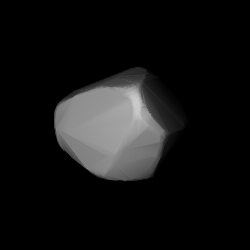
1623 Vivian is a carbonaceous Themis asteroid from the outer region of the asteroid belt, approximately 25 kilometers in diameter. It was discovered on 9 August 1948, by South African astronomer Ernest Johnson at Johannesburg Observatory in South Africa. It was named after Vivian Hirst, daughter of British astronomer William P. Hirst.


















